Returning to the Village
For those of us who live in urban areas, what does returning to a life in the village really mean? What is the impulse that moves folks to reverse the direction of migration of their recent ancestors to the city? What can living on the land, growing your own food, and using your hands to make clothing and shelter offer souls hungering for a real connection to the Earth? Here, Hang Mai, a Vietnamese natural farmer and social entrepreneur, who together with her partner Chau Duong mid-wifes those wanting to make this transition to the village, reflects on this question.
I belong to the baby-boomer generation in Vietnam after the end of the war in 1975. My generation experienced the difficult life in the city after the war. We did not have enough food, clothing, or even clean water. After school, all of us children were involved in housework like standing in line to collect water, carrying water home by foot or by a wagon. We all had to find a way to fetch enough water for our family. Once I asked my dad: “If the war happens again, and we don't have water and electricity, what shall we do?” He said: “Go back to the village.”
So I began to understand that in the war time people can go back to the village or go to the forest. Only in the village or in the forest can we find food and shelter. In times of peace, people destroy the forest and leave the village to join the city. Like many of my peers, I only came back to the village during summer breaks, and we all wanted to stay in the city. The movement was one direction: from the village to the city, from the smaller city to the bigger one, and from the bigger city to the mega city. The village gradually became empty.
However, in recent years, in Vietnam, I have seen an upstream flow from the city back to the village. It is a small flow, but persistently runs along the side of the mainstream rural-urban migration. When I look at this upstream flow, I can categorize 5 groups:
Group 1: Those who want to farm as a form of therapy
Group 2: Those who want to farm as a leisure activity
Group 3: Those who farm as a livelihood
Group 4: Those who choose farming as a way of living and of self-sufficiency
Group 5: Those who choose farming as a way of living and make surplus to sell
Most people belong to groups 1 and 2. Group 3 is quite significant, too. Some are successful in making a living out of farming, but a lot of people fail. There is a gradual increase in group 4. Those are young people who leave the city and go back to their families in the village. They chose to farm on their family land and become self-employed. Group 5 is the smallest. Some people from groups 3 and 4 started joining group 5.
I would like to invite you to meet young people from group 4 and learn their stories.
---------------------------------
TRANG BUI (Hanoi)

I learned natural dyeing techniques from my friend’s mother who is H’Mong. I just shadowed her and did what she told me to do. Dyeing took about 2-3 hours a day. The rest of the time I helped with housework like chopping vegetables for the pigs, peeling corn for the chicken, weeding and harvesting vegetables. I did whatever was needed to be done. We often did housework together. I did as much as I could without any pressure. People did not emphasize productivity. The most important thing is sharing the work and doing it together.
I dye the fabric and use it to make clothing and accessories. Not long ago I started planting trees for dyeing substance and weaving, too. I realised that I have almost no need for buying anything or spending any money, so I decided to leave the city to live in farms. At the farms we can grow our own food and have time to take care of ourselves. I go back to Hanoi every two months. Once I find a farm that is a good fit, I will move there permanently.
My friends often complain that I charge too little for my indigo-dyeing products. I cannot set a high price, because I want to sell to people who share the same lifestyle. Those who farm and earn little money cannot afford a high price. My friends told me that the price does not reflect the high quality and value of handmade products.
I think the value of a product should be determined by the producer. If I think it is enough, it should be enough.
I hope to live in a community where each member can do something with their hands: growing food, raising animals, making furniture, house, tools and clothing. We can exchange our products.Earlier this year, when I lived on a farm, I repaired clothes for people in exchange for pineapples. They tasted yummy. I recently stayed with a friend and helped my friend with home improvement. In exchange, my friend provided me with food and shelter.
This reminds me that before machines, humans used their hands to make everything. That is why I wants to exchange my products with other homemade items. I was very happy when I exchanged my products for mango, peanut, salted apricot, seaweed and even two books (which I love). I hope I will meet more friends who share this path and learn interesting things in sharing and exchange our homemade products.
----------------------------------------
NHAT NGUYEN (Quang Nam province)
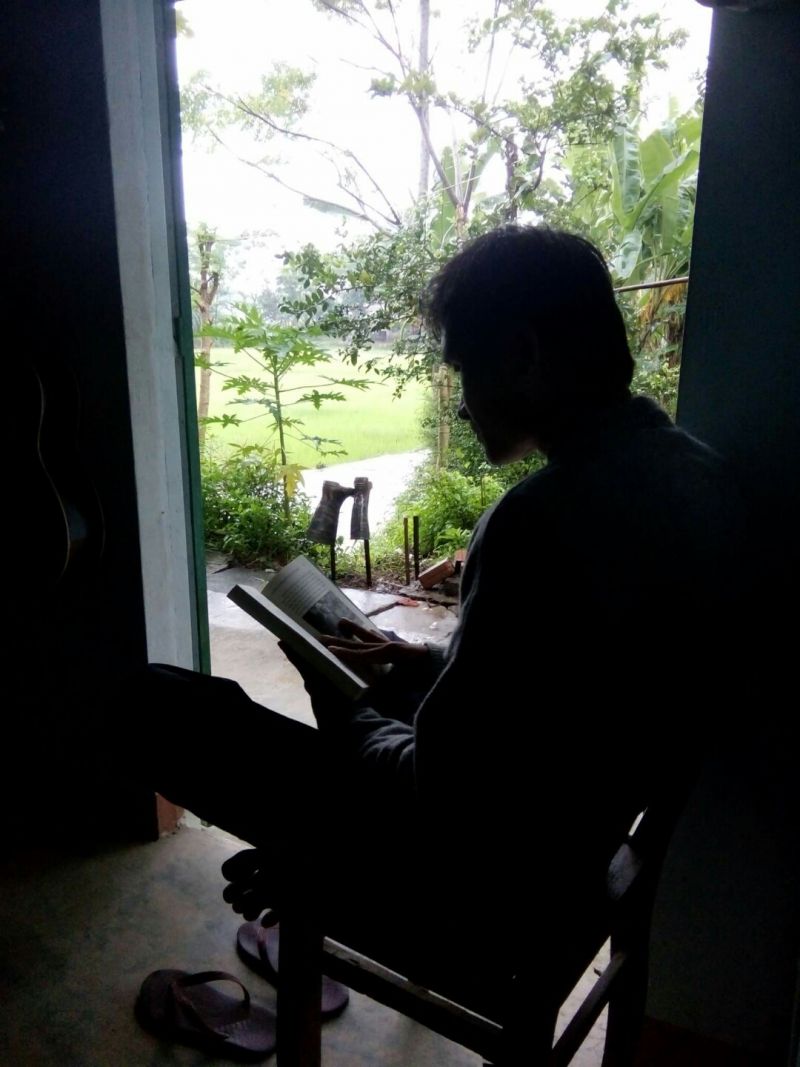
I was born and grew up in a poor family. My parents are farmers and practice Buddhism. We live in a small island in central Vietnam. It is a flooded area. I graduated from university with an engineering degree in energy and environment technology. I worked for two years as an engineer and applied what I learned, but I found no meaning in life.
I left my job to have time for reflection. During this time, I asked myself: “Why don’t I grow my own food? Why do I need to go to work to earn money to buy food, while my family has land and my needs are minimal?”
It is hard for any parent to accept that the child they sent to university with their hard-earned money now wants to go back to farming. I argued with my parents so many times. Facing my strong will and determination to start non-chemical farming, my parents had to agree for me to try it out.
I started selling vegetables in July 2017. My customers are university friends and people who are vegetarians. Today I have 60 regular customers. Every week I harvest the vegetables, wrap them in banana leaves and deliver them by motorbike to customers who live within 4-40 km from my house. I am happy to grow healthy food and to sell them at a good price. My customers are also happy to consume the healthy produce.
My family consists of 4 people. The total amount of land we own and rent is 5000 m2. I allocate 1000 m2 for food forest. We plant rice twice a year in 800 m2 and harvest 600 kg of dry rice. The rice is more than we need. We also plant vegetables, peanuts, corn, sweet potato, eggplant and squash. We produce more than we can eat.
We only need money to buy salt, sugar, soybean sauce, and spice. We spend the most money on death anniversaries and family gathering events. I want to gradually spend less money on this. Each month I only spend about 8-20 USD for gasoline, so I have no pressure to earn money.
As I started farming, I learnt a lot from others. I realized that the food forest should be multi-layered and bio-diversified. Since the mid-2018, I visited other farms. I was convinced that food forest is the right approach. I was really inspired. In the beginning of 2019, I started our food forest.
I am trying to reduce the distance between the growers and the customers. The closer to the farm the customers live, the better. I want to develop a long term contract between our farm and the customers, and provide seasonal produce. Each year I would like to take two months of winter vacation.
I am inspired by the lifestyle of “minimizing needs and knowing what is enough” and trying to practice it. This means to desire less for myself and to be grateful for everything in this life. I am happier everyday, I feel loved and I love more.
I will keep on gardening to become a better person who knows how to live in harmony with nature.----------------------------------
3 YOUNG LADIES: SEN TRAN, NHUNG HOANG, HANH PHAM (Dong Nai province)

The most frequent question people asked me for the last two years since I started gardening is “How can you earn a living by gardening?”
My friends and I decided to go to the countryside to do gardening after working together for 4 years in a government office. We left our job, learnt gardening and looked for land to buy. We did not have a lot of money. We decided to buy a garden with a small house on it, so we didn’t have to spend money to set up. We knew that we would not earn anything the first two years. So the question was: How to be most self-sufficient so we could spend the least money?
We often considered for a long time before buying anything. We only buy what we need, not what we want. This helps us to have good spending habits. We need about 80USD each month to cover the personal expense and some cost relating to gardening.
Understanding our needs helps us to plan to balance between gardening and earning some money.We try to do everything we can with our own hands, so we don’t need to buy things or pay for services. Our first priority is food sufficiency. As soon as we bought the garden, we started growing different kinds of beans and seeds, root vegetables and perennial plants. We also collect wild edible plants in the garden for our meals.
We exchange produce with other gardens and farms. Those who have extra bananas exchange them for sweet potatoes. We can enjoy a great variety of produce without having to plant all of them, and we also avoid surplus. When we visit friends, our gifts always come from our garden.
We also learn to make furniture such as tables and chairs, shelves for storage and for clothing. We collect used wood pallets and branches from our garden and from the neighbors. There is a carpentry workshop near us and they give us unused wood.
We use fruit skin to make enzymes for washing clothes and dishes. We collect soapberry and herbs to make shampoo. For toothpaste, we mix betel leaves, salt and lemon juice. We use wood logs for cooking. During the rainy season, we collect rainwater. During the dry season, we reuse washing water for watering vegetables. Because we have a food forest, we do not need much water during the dry season.
During the first year, we practice gardening skills and other skills to set up our new life. We have not earned money from gardening, but we receive so much joy from it.
The second year, we ran out of savings. We were thinking of different ways to earn some cash. We even considered that one of us would return to the city to earn some money, and one would stay in the village. But we no longer felt comfortable with city life, so we dropped that idea quickly. What shall we do to earn some money without having to leave our village or to compromise our simple lifestyle? After much consideration, we decided to sell breakfast in the local market. We cook breakfast food with produce from our garden and package them using banana leaves or paper bags. Gradually our customers started bringing their own containers to buy breakfasts.
Selling breakfast is the short term solution until we can earn some cash from our garden. We think we have the answer for the question people ask us:
We can make a living thanks to the garden, thanks to the local community and thanks to our own efforts.
---------------------------------
DAN VU (Ninh Binh province)
I used to work for 3 years in Japan. When I returned home, I asked myself, “What shall I do in Vietnam?” My close friend in Japan told me: “It would be good for you to spend a year or two to try, and to find out what you love to do. If you love what you do, then work feels like play. Then work is as enjoyable as playing soccer”.
People often told me I am good at selling, so I decided to work as a salesman in Hanoi. After trying for a year, I found that life in Hanoi is not healthy.
Even if I have money, money can’t buy good health. I decided to go back to the village.
I met a friend who gave up an opportunity to stay in Japan and returned to the village to live with his parents. He said: “Living with my parents and talking to them everyday makes me so happy”. His story gave me more confidence in my decision to return to the village to be near my parents.
When I first returned home, I spent a lot of time observing the garden, reading and cooking. I started planting rice, raising chicken and growing beans. I learnt new skills in gardening and planting. I went around to collect seeds of fruits that my family loves, such as jackfruit, guava, custard apple, longan, mango, lychee, banana, papaya...and planted them in the garden.
I have a fond childhood memory of a neighbor's garden. When I was young, I loved that garden because it had so many fruit trees. I want to leave a beautiful garden like that to my children and grandchildren.
Our garden lot is about 1500 m2. We also have a rice field of similar size and a fish pond. This makes self-sufficiency easier.
My mother was a skillful straw weaver when she was young, but she gave it up for a long time. I encouraged her to resume this craft, and I would be responsible for selling.
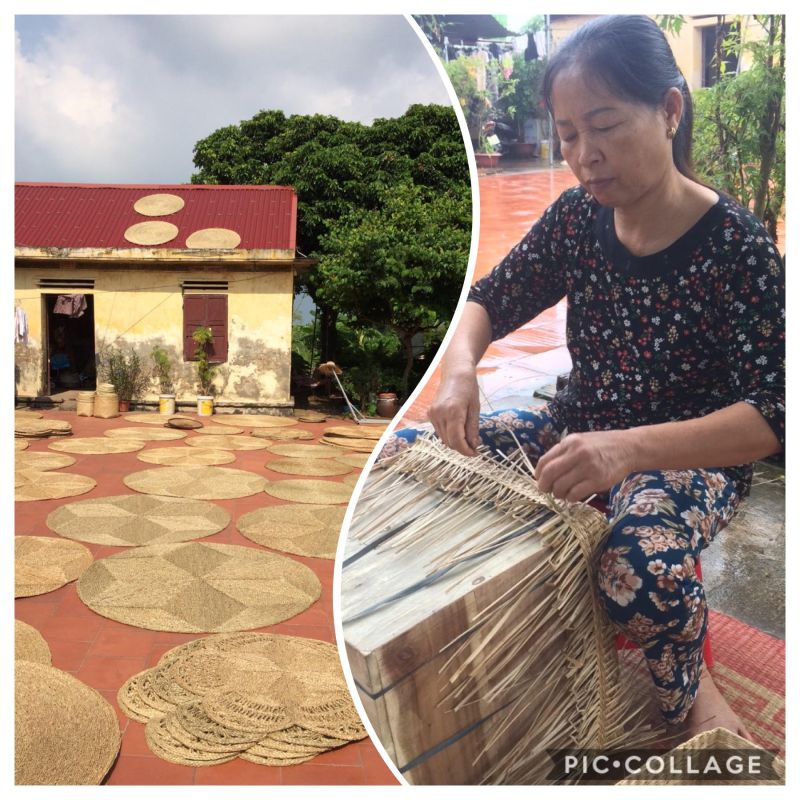
So now the main income for our family comes from our “side work”. We make and sell straw bags and straw carpets. The produce from our garden is enough for our meals. We also share the produce with other family members.
We produce about 80-90% of our own food such as rice, vegetables, fruit, fish, chicken, goose, and eggs. Our life is fulfilled.
------------------------------------
HUY and VY's family (Dong Nai province)
My husband and I returned to the village three years ago. At first, my husband Huy asked his parents for a small lot in the furthest part of their farm. We started planting what we needed most, such as vegetables, herbs, bamboo, fruit and forest trees. We collected seeds from friends and family, and made compost, so we didn’t need to buy them. All we needed was time and labor. After the first year, we produced more than we needed and started selling.
We think that if we work hard in our garden, we can earn as much as workers earn in the city. We feel healthy and it is enough. Even though we don’t earn much money, we also spend less.
We make a lot of things with our own hands, and we have much more time for ourselves and our families.
We received a lot of help from family and community. Huy’s parents shared part of their land and also shared their farming experience with us. When we moved to a new farm, the owner let us use a small lot to build a house and to work the land. Our neighbors gave us a lot of food, and friends came to help when we were in need. That’s how we live now, and how the previous generations used to live.
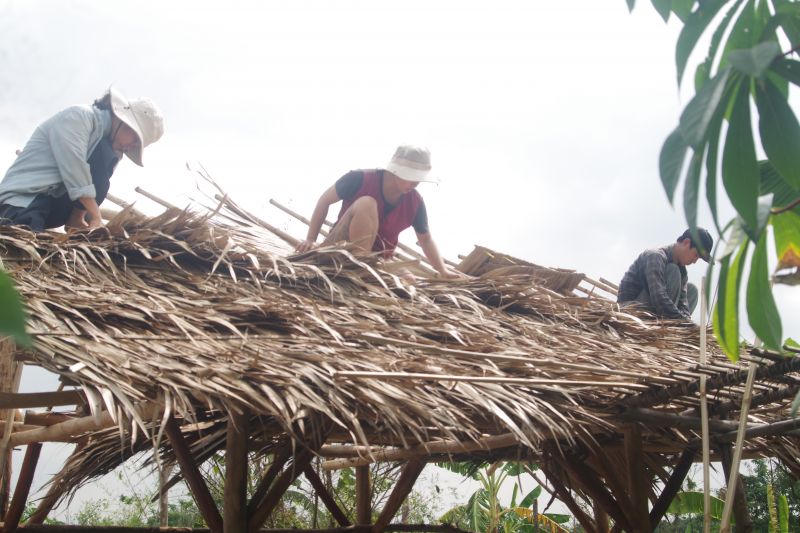
After some time living with Huy’s family, we decided to move out to start our independent life. In order to be less dependent on money, we need skills. Huy built our house, grows food in the garden, made our furniture and household items. When we need some cash, Huy works for the farm owner. When he has free time, he makes wooden spoons to sell. I am responsible for housework and taking care of our baby. Some friends see our life as rich and abundant, others worry that we don't have enough. We all think differently about what is enough. We can’t use one measurement, but each of us needs to look inward to know if we are satisfied or not.

A lot of people told us that our life-style is too extreme. They also warned us that we need to change once we have kids. Our son is 10 months old now, and everyday we know we made the right decision.
This lifestyle is right not only for us, but also for our son. After having him, we are sure that we need to live in a way that will not affect his future. We can’t live just to satisfy ourselves with comfort at the cost of depleting resources which belong to my son’s and future generations.We have a strong belief in our choice. We have not changed our lifestyle after having the baby, even though we face different challenges now.
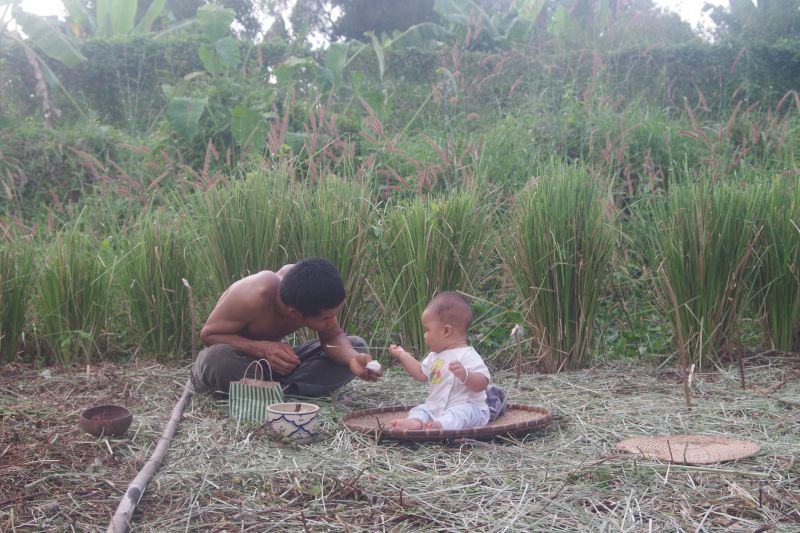
Everyday when I hold my baby on our walk, when I hold him to sleep, when I play with him, when I watch him grow, I tell myself to stay committed to the lifestyle of self-sufficiency and zero waste for his future.
The future will be the flowers blooming from the seed we plant and nurture today.------------------------
So those were stories from the young people who gave up the city and returned to the village.
These young people could be single or married, with kids or without. They could come from any area in the country. They own land, or they share land with their parents, or they use land that belongs to friends. They do whatever work is needed and possible: dyeing clothes or growing vegetables, selling homemade weaving products or cakes, selling sticky rice breakfast at the local market or making wooden spoons.
These stories are not about moving residence or changing livelihood. These stories are about the choice they make, the choice for a simple and self-sufficient life. This life is lighter for themselves and lighter for the Earth.
How about us -- what choices do we make?
These days we hear a lot about the coronavirus pandemic that has spread out in China and around the world. We all ask ourselves about the safety and security of our lives, lives of our loved ones, and our society. We can’t just think about the pandemic and the treatment, without thinking about the choices we make in our daily lives. Do we choose the global or local economy? Do we choose mega cities of large consumer markets but dependent on external resources, or small self-sufficient communities of farmers and producers?
Do we choose to change ourselves or to wait for the world to change?
Bill Mollison, founder of permaculture, said
“The greatest change we need to make is from consumption to production, even if on a small scale, in our own gardens. If only 10% of us do this, there is enough for everyone. Hence the futility of revolutionaries who have no gardens, who depend on the very system they attack, and who produce words and bullets, not food and shelter.”
Can we make this change? Of at least, can we support and respect people who make the choice of simple and self-sufficient life?
When I sent this article to the editor, she asked me following questions:
Q: These stories sound like Utopia. Do they face any challenges? Are they vulnerable?
A: They face many challenges. Some challenges come from within: how much is enough? What is my capacity? Some other challenges come from families and friends, or from poor soil, or from pollution, or from the damaged ecosystem. These young people choose the difficult path which many would not want to try.
Q: How long can they live like this?
A: I don’t know. But I know one thing: people who can work on short-term small steps, in order to reach the long-term goals will go far. They prepare some cash for short term needs and skills for their long term journeys.
Q: Are there many of them?
A: I don’t know. You can see the stream but you don’t know how many flows are joining and will be joining the stream.
This piece was written by Hang Mai & all the above friends mentioned in the piece and first featured as a ServiceSpace blog in March 2020. It was translated from Vietnamese into English by Giang Dang. For more inspiration, join the upcoming Awakin Talk with Hang Mai and Chau Duong! RSVP information here


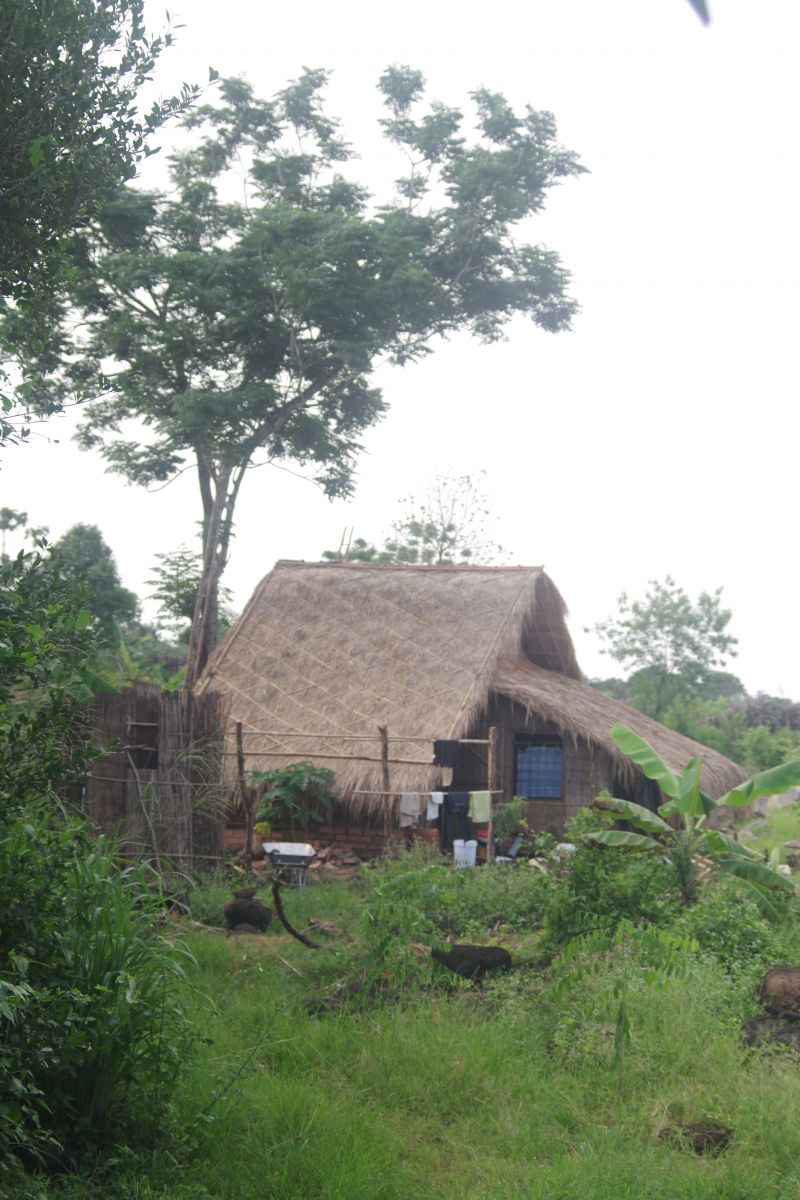

On Jul 8, 2021 Kristin Pedemonti wrote:
Thank you for sharing the details which help us understand how these choices work in Vietnam. I resonate so much with all stated here.
In the US, this choice is a bit more challenging because do not have many 'villages' to return to, land is expensive most places, so there is an additional layer to figure out how to overcome.
And yet I know many making similar choices: working in small organic farms, going "off the grid" building their own energy efficient small homes. This intrigues me too.
I've lived mostly simply the last 16 years since selling my home and most of my possessions to create/facilitate (upon invitation) a volunteer literacy program in Belize. Since then I've done my best to continually share my skills for free or reduced cost for those who need what I have to offer: these days Narrative Therapy practices to assist in recovery from trauma. My view is to share with those who need in exchange for what I may need. It mostly works out. I'd like to also move away from the east of US where it is so "driven" and competitive. I dream of where I might go outside the US as I do not resonate here.
With gratitude for your stories
[Hide Full Comment]Kristin
Post Your Reply